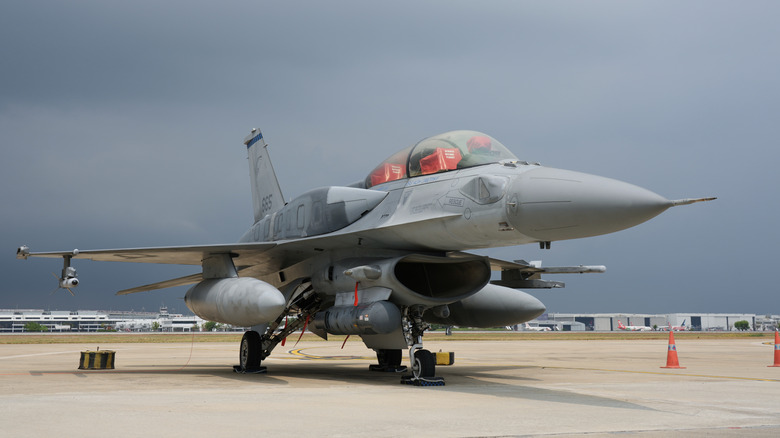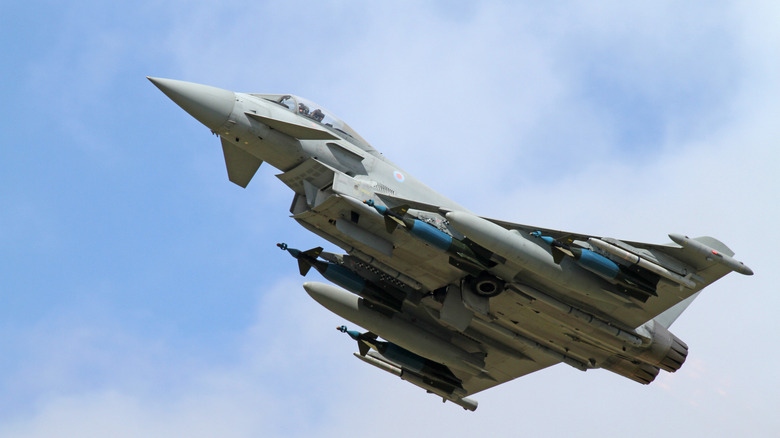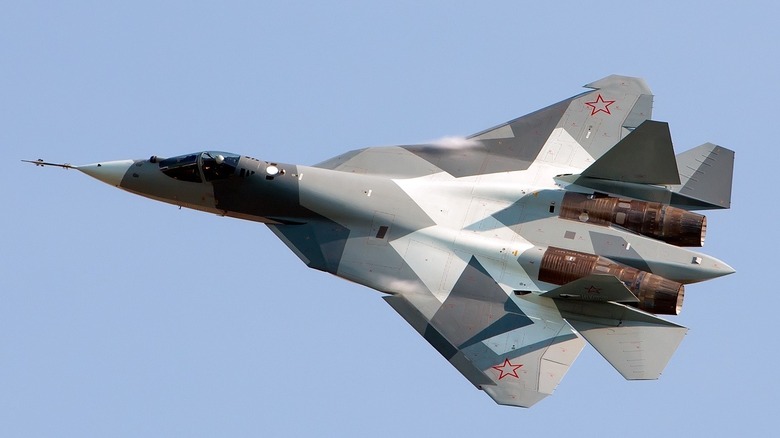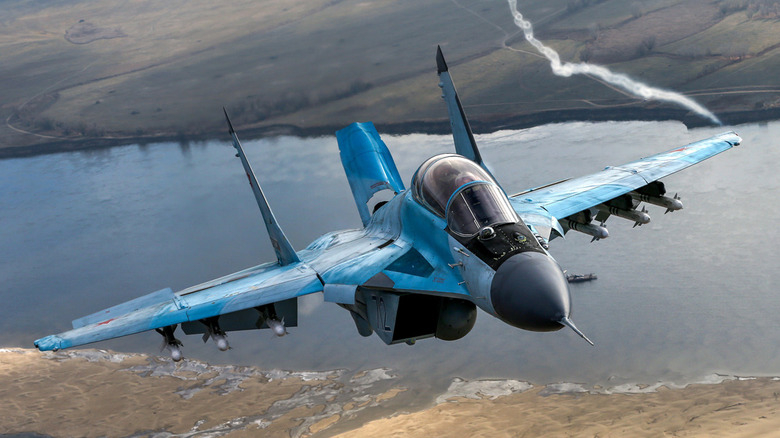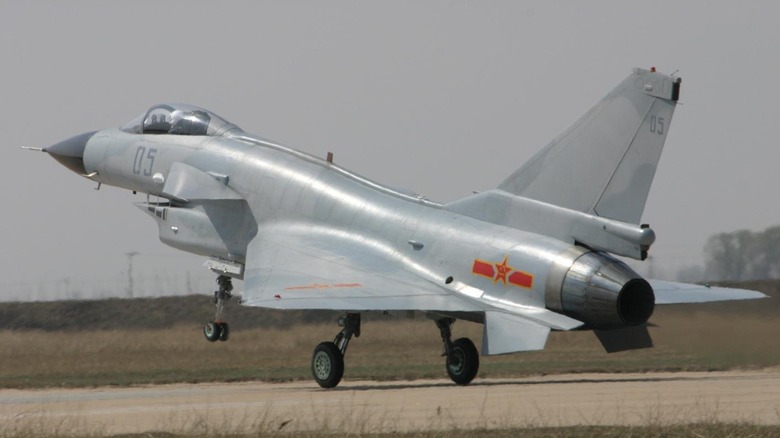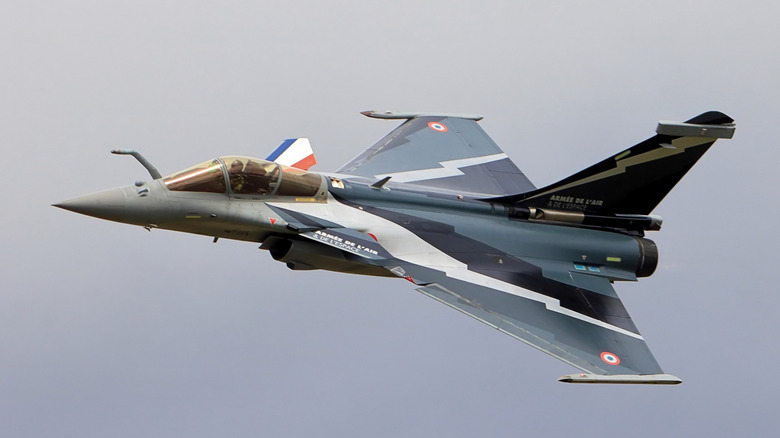5 Fighter Jets That Can Hold Their Own Against The F-16
By the 1970s, fighter jets had grown heavy, cumbersome, and no longer capable of the high-speed maneuverability that wins dogfights. General Dynamics (now part of Lockheed Martin) proposed an agile, lightweight fighter that would become one of the quickest and most lethal aircraft in the sky: the F-16 Fighting Falcon. In addition to extreme maneuverability, it featured a blended-wing body that increased lift, advanced fly-by-wire controls, and a more survivable ejection seat.
The Fighting Falcon's top speed of Mach 2+ and its quick-strike capability earned it the nickname of "Viper." In time, its role would grow beyond air-to-air fighting to include ground attack and close air support. And despite all this, it was relatively cheap. It was exported to more than two dozen countries, with over 4,500 built. But time moves on, aviation technology advances steadily, and the F-16 now operates in a world with potent rivals.
To determine which jets can hold their own against one of the most iconic fighter jets ever built, we'll look at aircraft that feature low weight, high speed, extreme maneuverability, multi-role capability, or a combination of these characteristics. In addition, these jets must feature modern avionics and weaponry to rival the Viper. And while alliances change and it's possible that an F-16 could find itself facing an American-built jet — for example, Iran flies U.S.-built F-14 Tomcats that it bought when it was a U.S. ally in the 1970s — the Viper's most likely foes will be foreign, so we'll limit our scope to fighters from countries other than the United States.
Eurofighter Typhoon
The Typhoon was built for maneuverability and serves as a multi-role fighter, much like the F-16. Many consider the Eurofighter Typhoon to be one of the best fighters ever built. Its construction consists largely of carbon fiber, giving it stealth characteristics since there are few metal surfaces to reflect radar. Its delta-wing design increases lift, similarly to the F-16's blended-wing design, while its forward canards give the Typhoon tremendous agility. Fly-by-wire controls, advanced avionics and weapons, and a greater than 1:1 thrust-to-weight ratio make it fast and deadly.
The Typhoon is a twin-engine fighter, whereas the F-16 features a single engine, giving the Typhoon a slight edge in top speed at Mach 2.35. The Typhoon offers 13 hardpoints for weapons versus nine on the Viper, although they both offer advanced weaponry for both air-to-air and air-to-ground combat. The F-16's cannon can fire a blistering 6,000 rounds per minute, compared to the Eurofighter's 1,600 rounds per minute. The F-16 is significantly less expensive, with some versions costing approximately one-quarter of the price of a Typhoon.
The Typhoon is also a complicated jet to operate and has been built in small numbers compared to the F-16. A Ukrainian pilot interviewed by Sky News gave his opinion of which jet he would prefer for his country's fight against Russia, and he concluded that the F-16 offers a much better supply chain for parts and weapons due to the vast numbers of F-16s that have been built. That being said, he still considers the Typhoon to be an excellent fighter.
Su-57 Felon
The Su-57 is very fast, highly maneuverable thanks to thrust vectoring, and bristling with advanced avionics and weaponry, not to mention Russia's claim of fifth-generation stealth features. On paper, it should beat the F-16, but in reality, it's a troubled plane. With several NATO members sending F-16s to Ukraine to assist that country in fighting off Russia's invasion, the question of which is superior, the Su-57 or the F-16, may cease to be an academic exercise.
The Sukhoi Su-57 Felon offers Mach 2 speeds and sophisticated maneuverability, along with a flight ceiling of 60,000 feet versus 50,000 feet for the F-16. The Felon bristles with radar-guided and heat-seeking missiles for air-to-air combat, along with rockets and bombs for ground attack. It can also field precision-guided cluster bombs and Kh-69 cruise missiles, which have recently been deployed against Ukraine. This combination of speed, agility, and multi-role capability makes it comparable to the F-16. In theory, its stealth should give it an edge.
However, some experts believe the Su-57's stealth technology is far behind American fifth-generation fighters, largely negating that theoretical advantage. Perhaps the jet's biggest problem is the number of Su-57 fighter jets that Russia has in its arsenal. Delays have limited production to 32 units as of late 2024. Russia has increased production, but deliveries still lag initial expectations as sanctions slow the assembly lines. This has led Russia to limit the Su-57's missions in Ukraine for fear of losing what few they have. The F-16, by contrast, has been extensively deployed in combat.
MiG-35 Fulcrum
Designed to be an agile multi-role jet with advanced avionics, Russia's Mikoyan MiG-35 is in a position to face off against the F-16 as the Ukrainian Air Force receives Fighting Falcons from NATO countries. The MiG-35 was designed to fight in hotly contested combat zones, so just as with the Su-57, the question of which jet is superior could be settled by real-world experience. At a glance, the MiG-35 appears to have the advantage.
The MiG-35, introduced in 2007, is considered a "fourth-generation-plus-plus" jet due to its advanced avionics and weapons, as well as a reduced radar cross-section. It's substantially larger than the F-16 and features two engines that power it to Mach 2.25. Due to its larger size, it carries a more powerful radar than the F-16, an advanced Active Electronically Scanned Array (AESA) radar. It's certainly one of the most advanced Russian fighter jets ever built.
However, as with the Su-57, the MiG-35 has been built in lower numbers than originally planned. Furthermore, it has failed to find the export market that Russia had hoped for, largely due to performance issues that have caused foreign buyers to turn away. Egypt and India had both been interested in buying it, but both countries turned to alternatives, demonstrating the real-world performance concerns that could limit the MiG-35's success in combat against the F-16 and other jets.
Chengdu J-10C Vigorous Dragon
The J-10C had its moment in the sun during the 2025 India-Pakistan conflict, and China is hoping to capitalize on its apparent success in combat to challenge the F-16 in global sales. It appears that Pakistan's J-10 aircraft disrupted India's airstrikes on Pakistan's territory, reportedly shooting down at least two of India's prized Dassault Rafale jets in the process. According to a Reuters report, it's likely that faulty intel caused India to underestimate the range of the J-10C's PL-15 air-to-air missile.
It was a successful trial by fire for China's Vigorous Dragon fighter, which resembles the F-16 in a number of ways. It even looks like the American fighter, except for the addition of the J-10C's forward canards. It's an agile, single-engine, fly-by-wire multirole fighter whose engines generate slightly more thrust than those of the F-16.
Like the F-16, the J-10C sports an Active Electronically Scanned Array (AESA) radar and a wide range of weaponry. Both jets feature advanced avionics and Electronic Warfare Systems. The J-10C is believed by some experts to have longer-range radar and greater maneuverability, with the latter resulting from its canards and a thrust-vectoring system. However, the F-16 has a much longer and impressive record in many theaters of combat.
Dassault Rafale
The J-10C's apparent success against the French-built Dassault Rafale came as a shock to many observers, since the Rafale is considered to be a highly capable aircraft. It's a multirole fighter jet known for being an agile dogfighter, putting it in the same general category as the F-16. However, as a 4.5-generation fighter with a reduced radar cross-section, it could possibly hold an edge over its American rival.
Similar to the Eurofighter Typhoon, the Rafale is a delta-wing plane with forward canards. This helps to give it exceptional maneuverability. The Rafale is a twin-jet fighter capable of cruising at Mach 1.8, slightly slower than the F-16. The Rafale features an Active Electronically Scanned Array (AESA) radar, one with particularly advanced features, including the capability to track up to 40 targets simultaneously. It also carries an electronic warfare suite known as SPECTRA, which fuses data from multi-spectral sensors to track and counter a range of attacks.
Despite the Rafale's issues in the recent conflict with Pakistan, India is still confident enough in the jet to order more of them to complement its existing fleet of 36. It may also order 26 Rafale M fighters for carrier-based operations. India values the Rafale's ability to carry out deep-strike missions in addition to its air-to-air combat capabilities. Plus, having its air force and navy using variants of the same jet will improve logistics and joint operations between the services.
